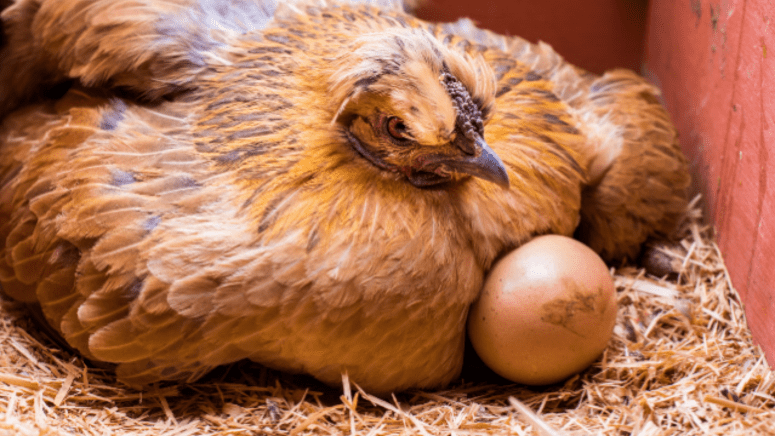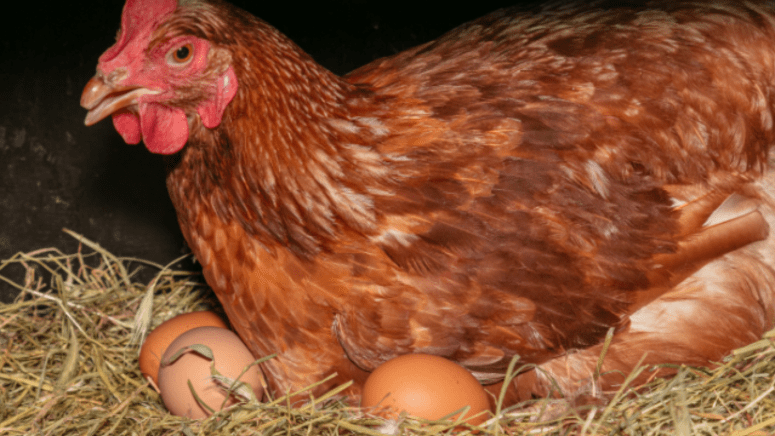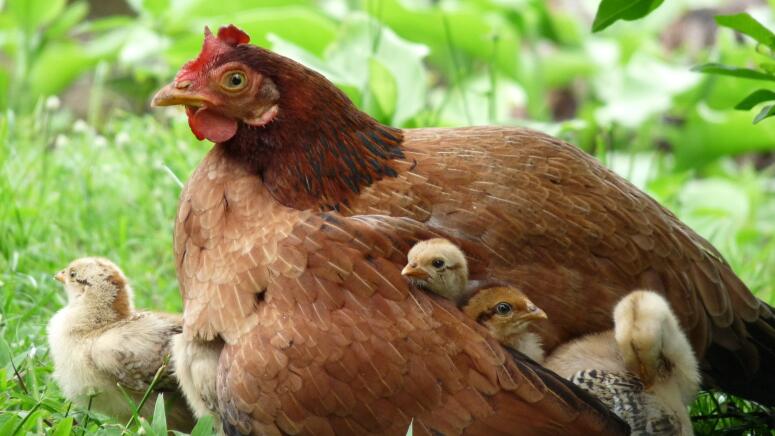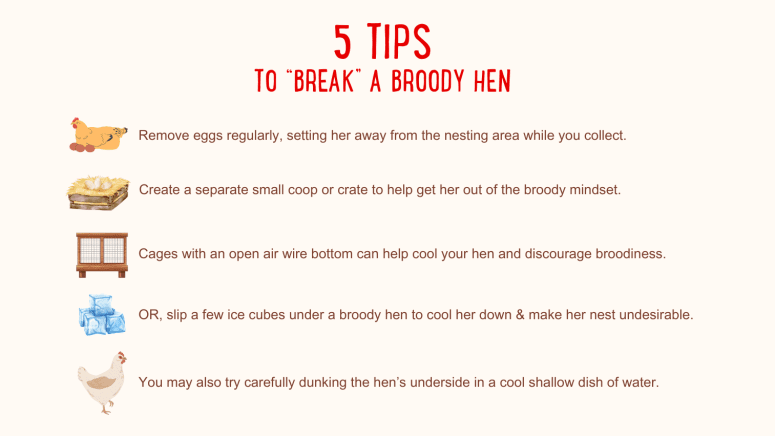Posted by Laura Hepburn, Thu, Aug 18, 2011; updated Wed, June 22, 2023
What is a "Broody" Hen?
If you keep a variety of chickens in your flock, chances are you have at least one hen that likes to go broody. “Going broody” is when a hen decides she would like to hatch some of her eggs and sits on them for an extended period of time, allowing her body temperature to increase and often consuming less food and water than she would normally.
For those who want their girls to hatch some fertilized eggs, this is just fine. You’ll need to make sure they have easy access to food and water, usually by placing a small waterer and feeder within very close proximity to their nesting box.

But, for people who want eggs only for consumption, a broody hen can be a bit of a pain. For one thing, you want to make sure your hens get the food and water they need, especially during hot summers. Breaking a hen of her broodiness will help ensure that she will eat whenever she’s hungry and drink when thirsty.
Broody hens can also experience a slowdown of egg production, especially if they hoard eggs from the other hens and feel they have a full nest. I have two hens that tend to go broody and they love to adopt the eggs from the rest of my flock!
One of the other concerns is that broody hens can get a little aggressive. Some hens will not only sit on a bunch of eggs, but strongly object to your trying to take them by pecking and yelling at you.

How to Tell If a Hen is Becoming Broody:
Symptoms of Broody Hens
Identifying a broody hen early can help manage her behavior effectively. Common signs include:
- Consistent nesting, where the hen spends extended periods in the nest box, often resisting leaving even for food or water
- Increased aggression, pecking or fluffing her feathers when approached
- Vocal changes, such as more frequent or unusual clucking, can indicate broodiness
- Gathering and sitting on eggs, regardless of their fertility
- Plucking her own feathers to line the nest, creating a warm, insulated environment for what she believes will be her future chicks
Recognizing these symptoms promptly can aid in addressing broody behavior before it fully sets in.

What Age Do Hens Go Broody?
Hens can start showing broody behavior once they reach their laying maturity, which depends on the breed. Broodiness often manifests after their first couple of eggs.
Some breeds, known for their maternal instincts like Silkies and Cochins, may exhibit broodiness earlier and more frequently. However, environmental factors, flock dynamics, and individual temperament also play significant roles in when a hen might go broody.
Monitoring your flock's behavior as they mature will help you identify broody tendencies specific to your hens.
How Many Times a Year Do Hens Go Broody?
The frequency of broodiness in hens can vary greatly depending on the breed, individual temperament, and environmental conditions. Some hens may never exhibit broody behavior, while others might go broody multiple times a year.
Breeds with strong maternal instincts, like Silkies and Cochins, are more prone to frequent broodiness, potentially going broody several times within a year.
Environmental factors such as the season, daylight hours, and nesting conditions can also influence broodiness. It's common for hens to become more broody in the spring and early summer, aligning with natural reproductive cycles and favorable conditions for raising chicks.
How Many Chicks Can a Broody Hen Keep?
The number of chicks a broody hen can successfully raise depends on her size, breed, and mothering abilities. Generally, a hen can comfortably brood and care for about 6 to 12 chicks.
Broody Breeds
It should also be mentioned that while specific hens of any breed can be rather broody, there are some breeds that are notorious for it.

Silkies
Silkies are famous for being broody hens; in fact, many people keep silkies around to use specifically for hatching new chicks. They will hatch just about anything and are good mothers as well.
Other Broody Breeds
Other breeds that have been known to go broody at times are Australorps, Brahmas, Cochins, Faverolles, Orpingtons, Plymouth Rocks, Sussex and Wyandottes (although none of these breeds are as prone to broodiness as Silkies and will vary widely depending on the individual bird).
What to Do With a Broody Hen?
There are two ways you can deal with a broody hen. Embrace her broodiness and give her some eggs to nurture, or try to distract her from the behavior and encourage her to engage in alternative activities. Here are some ideas:
- Increase Foraging Opportunities. Broody hens often spend most of their time sitting and less time engaging in natural behaviors like foraging. By enhancing the foraging opportunities in your coop or run, you can encourage your broody hen to take more interest in her surroundings. This can be done by scattering her favorite treats around the area, encouraging her to get up and move around. The increased physical activity can help shift her focus away from brooding.
- Introduce New Enrichment Items. Boredom can sometimes exacerbate broody behavior. Introducing new enrichment items such as perches, dust baths, or even hanging vegetables like cabbages or lettuces for pecking can stimulate your hen's curiosity and encourage more active behaviors. These distractions can help break the monotony and reduce the urge to sit and brood.
- Adjust the Light Exposure. Light plays a significant role in poultry behavior and physiology, including broodiness. Increasing the daylight hours your hens are exposed to can sometimes help reduce broody tendencies. This can be done naturally by allowing more natural light into the coop or artificially with the use of a coop light. It's important to use this method cautiously and avoid excessive artificial light, which can lead to stress.
- Social Interaction. Sometimes, the company of other chickens can help distract a broody hen from her instincts. If possible, consider gently integrating your broody hen with the more active members of the flock, ensuring they are not aggressive towards her. The social dynamics and interactions can help engage her in typical flock behaviors and deter her from returning to her nest.
- Monitor and Adjust Diet. Nutrition can influence a hen's tendency to brood. Ensuring your broody hen has a balanced diet rich in essential nutrients can help maintain her overall health and reduce the likelihood of prolonged broody periods. Consult with a poultry nutritionist or veterinarian to assess and possibly adjust her diet.

5 Simple Tips to “Break” a Broody Hen:
- Be sure to remove eggs from under the hen regularly and, if possible, pick her up and set her away from the nesting area while you collect them.
- Create a separate environment for her using a small portable coop or crate. Removing her from the nesting boxes and eggs could help get her out of the broody mindset.
- Putting her in a cage with a wire bottom, open to the air, can help cool her underside and disengage her from the broody feeling.
- If using a wire-bottom cage doesn’t work or isn’t an option, some people slip a few ice cubes under a broody hen a couple of times a day, which can result in cooling her temperature and making her “nest” undesirable.
- Similar to the ice cube method, some people have found success by simply dunking the hen’s underside in a shallow dish of cool water.
These are just a few quick tips that many chicken owners have found useful when breaking a hen of her broodiness, but there are a lot of techniques out there.
If changing your hen’s environment and cooling down her body temperature don’t work, try asking some experienced chicken owners if they have any suggestions. If YOU are an experienced owner and have developed your own methods for breaking a broody hen, please post them in the comments. We would love to hear your ideas!
Feature Products

